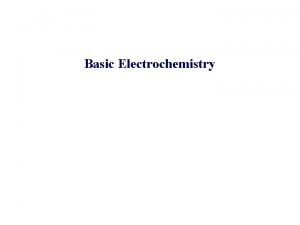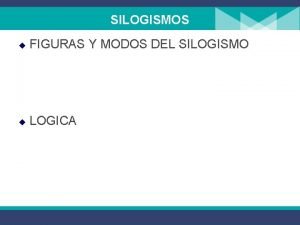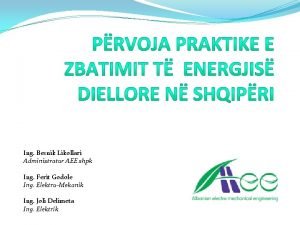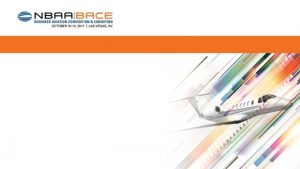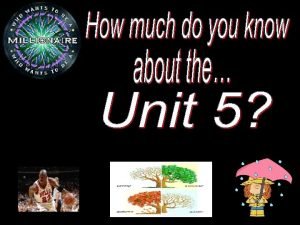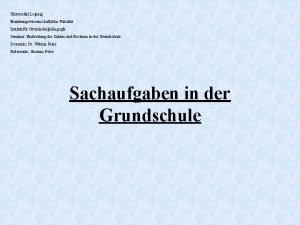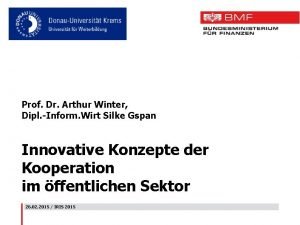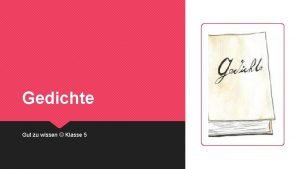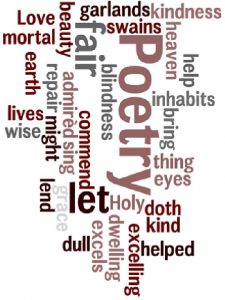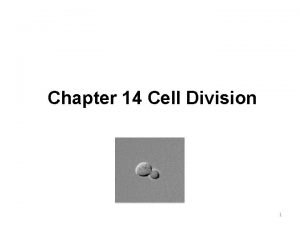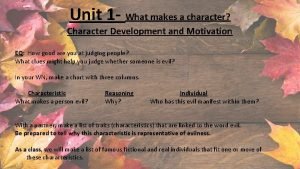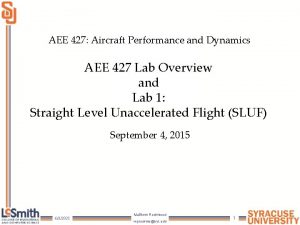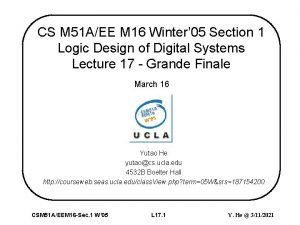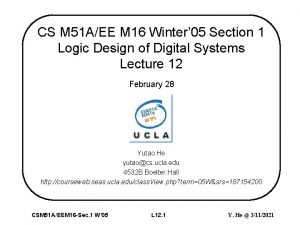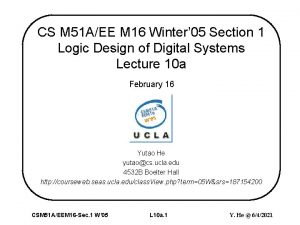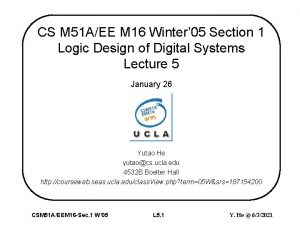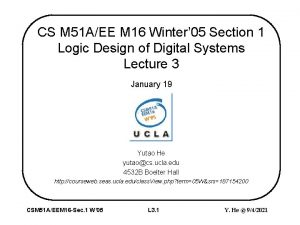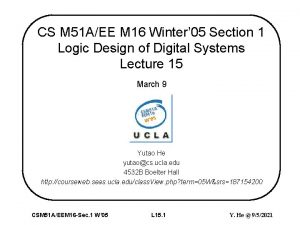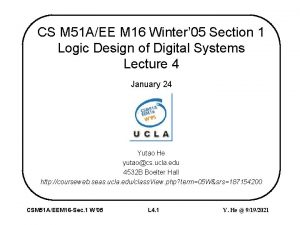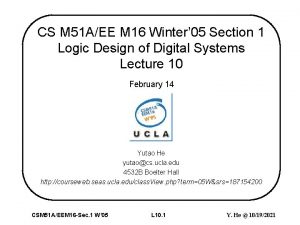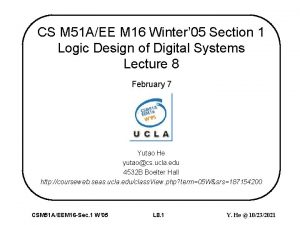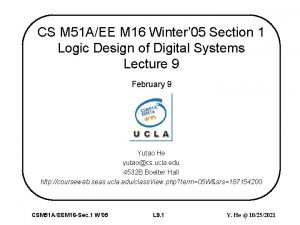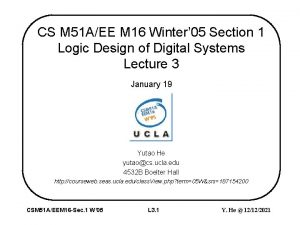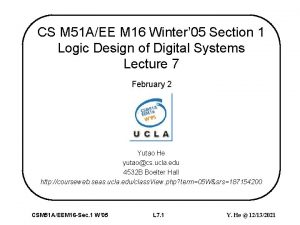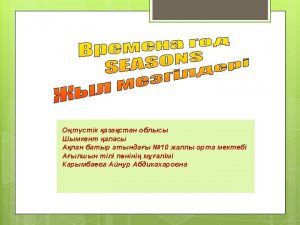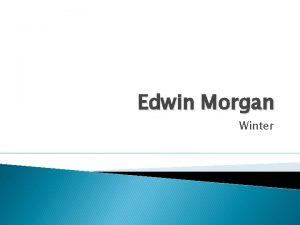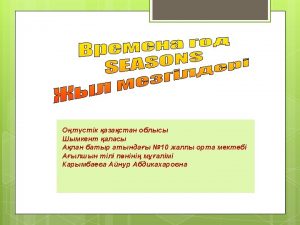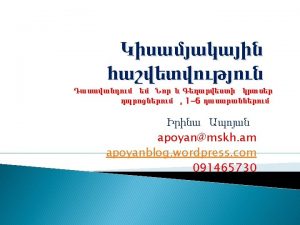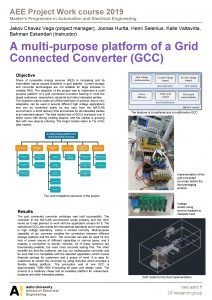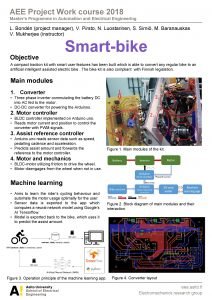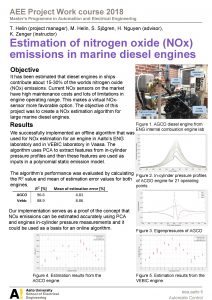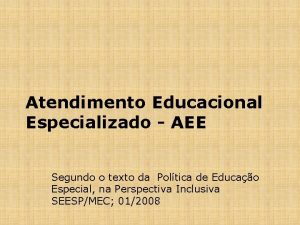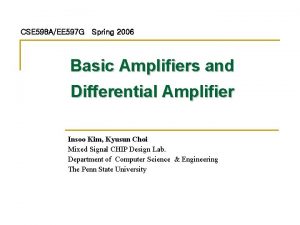CS M 51 AEE M 16 Winter 05

































- Slides: 33

CS M 51 A/EE M 16 Winter’ 05 Section 1 Logic Design of Digital Systems Lecture 1 January 10 W’ 05 Yutao He yutao@cs. ucla. edu 4532 B Boelter Hall http: //courseweb. seas. ucla. edu/class. View. php? term=05 W&srs=187154200 CSM 51 A/EEM 16 -Sec. 1 W’ 05 L 1. 1 Y. He @ 10/26/2021

Outline • Welcome • Chapter 1 - Class Overview • Summary CSM 51 A/EEM 16 -Sec 1 W’ 05 L 1. 2 Y. He @ 10/26/2021

Why Are We Here? • Because the computer is everywhere! Welcome to the class! CSM 51 A/EEM 16 -Sec 1 W’ 05 L 1. 3 Y. He @ 10/26/2021

Course Administration • • • Instructor: Yutao He (yutao@cs. ucla. edu) Office Hours: MW 6 -7 pm (4750 BH) TA: Kenneth Leung (kyleung@ucla. edu) Office Hours: TTh 1 -2 pm (4428 BH) Textbook: Introduction to Digital Systems by Ercegovac, Lang, and Moreno John Wiley & Sons, 1999 • Course Website: – http: //courseweb. seas. ucla. edu/class. View. php? term=05 W&srs=187154200 CSM 51 A/EEM 16 -Sec 1 W’ 05 L 1. 4 Y. He @ 10/26/2021

res u t c ns Le o i s cus s i ekly k D e W wor e cts e m kly j e o o e H Pr Bi-w zzes rm, e t Qui Mid al Fin CSM 51 A/EEM 16 -Sec 1 W’ 05 L 1. 5 Hom ewo 10% rk Course Structure Final 40% s ct e oj % r P 10 zes z i Qu % 10 Midterm 30% Y. He @ 10/26/2021

Homework • • • Available on-line every Monday before the class Due at 4 pm on the following Monday Drop off in the class mailbox in Room 4428 BH Each homework hand-in should attach a cover sheet Solution is available on-line Tuesday 9 Homework in total CSM 51 A/EEM 16 -Sec 1 W’ 05 L 1. 6 Y. He @ 10/26/2021

Quizzes • • To get you acquainted with Midterm and Final To have you keep up with the class progress 3 quizzes in total Given every two weeks at the end of Friday session Closed-book and Closed-note 30 minutes Test class materials covered in the past two weeks CSM 51 A/EEM 16 -Sec 1 W’ 05 L 1. 7 Y. He @ 10/26/2021

Projects • To get hands-on experiences on current industry practice (EDA tools dominated) • 2 or 3 small projects • Design simple digital systems in VHDL • Use the Altera MAX+PLUS II toolkit • May team up with your fellow classmates • SEASNET accounts are required unless you have PC at home CSM 51 A/EEM 16 -Sec 1 W’ 05 L 1. 8 Y. He @ 10/26/2021

Midterm and Final • Goal is to test knowledge not to test speed writing • Midterm – Date: 2 -3: 50 pm Friday, February 18 – Location: in the lecture room – Closed-book/Closed-note but allows a cheat-sheet • Final – Date: 8 -11 am Monday, March 18 – Location: TBD – Closed-book/Closed-note but allows a cheat-sheet CSM 51 A/EEM 16 -Sec 1 W’ 05 L 1. 9 Y. He @ 10/26/2021

Academic Integrity • Studying in groups is encouraged • Actual work must be your own PLAGIARISM • Common cheating scenarios: – running out of time on an assignment and then cut-andpaste from your buddy’s work – cross-talking and cross-eyeing during exams • Will be reported to Dean’s Office if catch any violation CSM 51 A/EEM 16 -Sec 1 W’ 05 L 1. 10 Y. He @ 10/26/2021

Course Problems • Can’t make quizzes or exams – should ask for permission ahead of time – the score would be zero unless some unexpected emergencies • Forget to turn in homework or your pet dog ate it – Only one time is allowed CSM 51 A/EEM 16 -Sec 1 W’ 05 L 1. 11 Y. He @ 10/26/2021

Course Protocols • • Please do not have small talk Please do not read newspapers Please do not wear the headphone Please put your cell phone in a non-disturbing mode Sleep is ok as long as you make sure not to snore Quiet food is allowed Don’t be shy to ask any questions occur to your mind – Don’t get intimidated if some fellow students happen to know better than you in the beginning – That’s why you take the class CSM 51 A/EEM 16 -Sec 1 W’ 05 L 1. 12 Y. He @ 10/26/2021

What You Need to Do Well • You have common sense – There are 12 months in a year • You can count properly – 1+1 = ? • You can do logic reasoning – if I miss one lecture, then I’ll fail the class • You have the positive motivation – I’ll shoot for an A+ • You know how to work smart CSM 51 A/EEM 16 -Sec 1 W’ 05 L 1. 13 Y. He @ 10/26/2021

What We will Learn • Language of logic design – Boolean algebra, logic minimization, state, timing, CAD tools • Concept of state in digital systems – Analogous to variables in software systems • How to design/analysis digital systems • Contrast with software design – Both map well-posed problems to physical devices – Both must be flawless CSM 51 A/EEM 16 -Sec 1 W’ 05 L 1. 14 Y. He @ 10/26/2021

Applications of Logic Design • Conventional computer design – CPUs, memories, busses, peripherals • Networking and communications – Phones, modems, NICs, routers • Embedded products – Cars, PDAs, entertainment devices • Scientific equipments – Testing, measuring, sensing, reporting • World of computing much bigger than just PCs! CSM 51 A/EEM 16 -Sec 1 W’ 05 L 1. 15 Y. He @ 10/26/2021

A Brief Historic Flashback • 1850: George Boole invents Boolean algebra – Maps logical propositions to symbols – Permits manipulation of logic statements using mathematics • 1938: Claude Shannon links Boolean algebra to switches – His Masters’ thesis • 1945: John von Neumann develops first stored program computer – Its switching elements are vacuum tubes • 1947: Shockley, Brittain, and Bardeen invent the transistor – enable integration of multiple devices into one package – gateway to modern electronics CSM 51 A/EEM 16 -Sec 1 W’ 05 L 1. 16 Y. He @ 10/26/2021

Follow-on Courses • CS 152 A (Lab) • CS 151 B (Computer Architecture) • CS 152 B (Lab) CSM 51 A/EEM 16 -Sec 1 W’ 05 L 1. 17 Y. He @ 10/26/2021

Questionnaire • Help us better know your background and thus teach the course more effectively. CSM 51 A/EEM 16 -Sec 1 W’ 05 L 1. 18 Y. He @ 10/26/2021

Hardware Systems • A simple model of a hardware system is a unit with inputs and outputs: inputs CSM 51 A/EEM 16 -Sec 1 W’ 05 system L 1. 19 outputs Y. He @ 10/26/2021

Analog vs. Digital • Digital: It has only discrete input/output values – In computer systems, only 0 and 1 are used • Analog: It has continuous input/output values – In reality, real electronic components exhibit analog behavior CSM 51 A/EEM 16 -Sec 1 W’ 05 L 1. 20 Y. He @ 10/26/2021

Combinational vs. Sequential • Combinational: – a digital circuit is combinational if its current output values only depend on its current input values – means "memory-less” – AND, OR gates • Sequential: – Exhibit behaviors (output values) that depend not only on the current input values, but also on previous input values – In reality, all circuits are sequential CSM 51 A/EEM 16 -Sec 1 W’ 05 L 1. 21 Y. He @ 10/26/2021

Synchronous vs. Asynchronous • Synchronous: – The outputs can only change at prescribed time instant • Asynchronous: – The outputs can change at any time instant CSM 51 A/EEM 16 -Sec 1 W’ 05 L 1. 22 Y. He @ 10/26/2021

Systems Studied in the Class • Digital • Both Combinational and Sequential • Synchronous inputs CSM 51 A/EEM 16 -Sec 1 W’ 05 system L 1. 23 outputs Y. He @ 10/26/2021

Big Picture of Digital Systems Design Idea Specification Logic Design Physical Design Fabrication CSM 51 A/EEM 16 -Sec 1 W’ 05 L 1. 24 Y. He @ 10/26/2021

Course At-A-Glance • Specification: – Spec. of combinational systems: Ch. 2 and 4 – Spec. of sequential systems: Ch. 7 • Implementation: – Physical level: Ch. 3 – Combinational Systems • at the gate level: Ch. 5 and 6 • at the module level: Ch. 9, 10, and 12 – Sequential systems • elementary: Ch 8 CSM 51 A/EEM 16 -Sec 1 W’ 05 L 1. 25 Y. He @ 10/26/2021

An Example • Calendar subsystem: number of days in a month (to control watch display) – used in controlling the display of a wrist-watch LCD screen – inputs: month, leap year flag – outputs: number of days CSM 51 A/EEM 16 -Sec 1 W’ 05 L 1. 26 Y. He @ 10/26/2021

Implementation in Software int number_of_days (month, leap_year_flag) { switch (month) { case 1: return (31); case 2: if (leap_year_flag == 1) return (29) else return (28); case 3: return (31); . . . case 12: return (31); default: return (0); } } CSM 51 A/EEM 16 -Sec 1 W’ 05 L 1. 27 Y. He @ 10/26/2021

Implementation in Hardware • • Encoding: – how many bits for each input/output? – binary number for month – four wires for outputs: 28, 29, 30, and 31 Behavior: month – combinational – truth table specification leap d 28 d 29 d 30 d 31 CSM 51 A/EEM 16 -Sec 1 W’ 05 L 1. 28 Y. He @ 10/26/2021

Specification: Truth Table month 0000 0001 0010 0011 0100 0101 0110 0111 1000 1001 1010 1011 1100 1101 111– CSM 51 A/EEM 16 -Sec 1 W’ 05 leap – – 0 1 – – – d 28 – 0 1 0 0 0 – – L 1. 29 d 29 – 0 0 1 0 0 0 0 0 – – d 30 – 0 0 1 0 – – d 31 – 1 0 0 1 0 1 – – Y. He @ 10/26/2021

Boolean Expression • symbol Truth-table to logic to gates symbol – d 28 = 1 when month=0010 and leap=0 for or for and for not – d 28 = m 8' • m 4' • m 2 • m 1' • leap' – d 31 = 1 when month=0001 or month=0011 or. . . month=1100 – d 31 = (m 8' • m 4' • m 2' • m 1) + (m 8' • m 4' • m 2 • m 1) +. . . (m 8 • m 4 • m 2' • m 1') – d 31 = can we simplify more? month leap d 28 d 29 d 30 d 31 0001 – 0 0 0 1 0010 0 1 0 0010 1 0 0 0011 – 0 0 0 1 0100 – 0 0 1 0. . . 1100 – 0 0 0 1 1101 – – – 111– – – 0000 – – – CSM 51 A/EEM 16 -Sec 1 W’ 05 L 1. 30 Y. He @ 10/26/2021

Implementation in Gate networks • • d 28 = m 8' • m 4' • m 2 • m 1' • leap’ d 29 = m 8' • m 4' • m 2 • m 1' • leap d 30 = (m 8' • m 4 • m 2' • m 1') + (m 8' • m 4 • m 2 • m 1') + (m 8 • m 4' • m 2' • m 1) + (m 8 • m 4' • m 2 • m 1) d 31 = (m 8' • m 4' • m 2' • m 1) + (m 8' • m 4' • m 2 • m 1) + (m 8' • m 4 • m 2' • m 1) + (m 8' • m 4 • m 2 • m 1) + (m 8 • m 4' • m 2' • m 4') + (m 8 • m 4' • m 2 • m 1') + (m 8 • m 4 • m 2' • m 1') CSM 51 A/EEM 16 -Sec 1 W’ 05 L 1. 31 Y. He @ 10/26/2021

Summary • That was what the entire course is all about – Converting solutions to problems into combinational and sequential networks effectively – Organizing the design hierarchically and systematically – Taking advantage of optimization opportunities – Analyze a digital system • Now let us do it again – This time we'll take the rest of the quarter! CSM 51 A/EEM 16 -Sec 1 W’ 05 L 1. 32 Y. He @ 10/26/2021

Next Lecture • Section 2. 3 - Data Representation and Coding • Class Note #1 CSM 51 A/EEM 16 -Sec 1 W’ 05 L 1. 33 Y. He @ 10/26/2021
 Aee cd20f
Aee cd20f Silogismo figuras y modos
Silogismo figuras y modos Plano de aee
Plano de aee Aee
Aee Aee shpk
Aee shpk Mc aee
Mc aee Aee shpk
Aee shpk Winter kommt winter kommt flocken fallen nieder
Winter kommt winter kommt flocken fallen nieder Heute mittwoch guten morgen mittwoch winter
Heute mittwoch guten morgen mittwoch winter Es war eine mutter
Es war eine mutter Wpc snow forecast
Wpc snow forecast Yesterday by patricia pogson
Yesterday by patricia pogson Winter driving safety topics
Winter driving safety topics Those winter sundays meaning
Those winter sundays meaning Winter ops solution
Winter ops solution Tithonus themes
Tithonus themes I usually wear
I usually wear Winter are snow temperature records
Winter are snow temperature records What do you do on weekends
What do you do on weekends Funktionen des sachrechnens nach winter
Funktionen des sachrechnens nach winter Tongue twisters winter
Tongue twisters winter Bundesverwaltung
Bundesverwaltung Mr frosty winter
Mr frosty winter Gedichte 5. klasse
Gedichte 5. klasse Winter safety brief
Winter safety brief My parents kept me from children who were rough
My parents kept me from children who were rough A tall winter's tale
A tall winter's tale Jennifer de winter
Jennifer de winter Four seasons korean movie
Four seasons korean movie Microcontrollers and embedded processors
Microcontrollers and embedded processors Weather spring summer autumn winter
Weather spring summer autumn winter Winter coloring page
Winter coloring page Chromosome duplication occurs during
Chromosome duplication occurs during Those winter sundays answer key
Those winter sundays answer key
